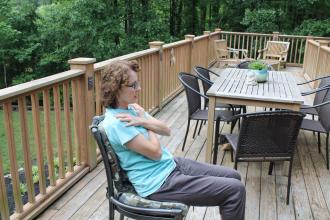News Taffy
| Post Your News Send Us An Event Start A Gallery |  |
| Most Recent | Most Popular | Top Contributors | Galleries | Events |
 | Contributor: admin subscribe to my stories |
 The Cardiologist's Wife - Tips on Improving Your Balance As we age, we begin to have problems with balance which can lead to falls and broken bones. Falls are a major cause of disability for the elderly so it is important to understand how the body balances so we can help ourselves stay healthy and safe. Balance starts to decline due to a lack of muscle strength and flexibility in the aging process. Certain diseases such as Parkinson’s and low blood pressure can also lead to problems with balance. You should keep up a regular exercise routine which includes strength training with weights and gentle stretching. Yoga and Tai Chi are excellent forms of exercise for flexibility and balance. The eyes work like a level, helping us to adjust our balance to changes in terrain even though we aren’t aware it’s happening. Cataracts, glaucoma or other visual changes can affect our eye’s ability to do their job. Make sure you visit your eye doctor regularly and wear your prescription eye glasses. Keep your home well lit so you can see where you are going and avoid stumbling. The ear contains semicircular canals lined with hair like structures, fluid and crystals which send messages to the brain, telling us where we are in space and whether we are moving. If you experience vertigo or dizziness, your doctor may check your ears for problems. Make sure to mention any dizziness to your doctor during your visits, even if it only occurs occasionally. There are many exercises you can do to help improve or maintain your balance. Try standing with your feet together behind a sturdy chair or at the kitchen counter. Lift one foot a few inches and hold it for a count of 10. Use the chair or counter for support if you need it. Repeat 5 or 6 times per foot. When this becomes easy, try doing it with your eyes closed or without holding onto the chair. Assume the same position as above but this time when you lift your foot, swing it back and forth as high as you are safely able without touching the floor. Switch legs. When this becomes easy, try doing it without holding onto the chair. To strengthen your ankles and calves, do toe raises. Simply stand in front of the chair or counter and raise up on your toes as high as possible. Hold for a count of 10 if you are able. Lower, rest a few seconds and repeat. Aim for 10 repetitions. Many elderly have trouble lowering themselves in a chair or rising back up. This next exercise will help strengthen your legs and improve your balance. Sit towards the front of a sturdy chair. With your arms crossed over your chest, lean back so your upper back touches the chair. Exhale and lean forward, swinging your arms out in front of yourself and rise from the chair in one smooth motion without using your arms to push or pull yourself up. Try 10 repetitions. If you are unable to do these exercises, you need to work with a trainer or exercise therapist until you are stronger. [+] add comment |

















